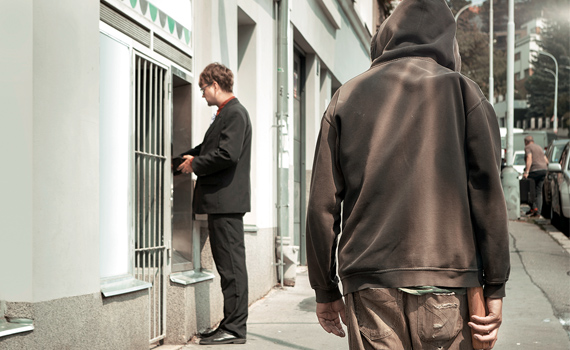ON THE STREET, CRIMINALS HAVE TO GET CLOSE TO YOU IN ORDER TO VICTIMIZE YOU. THEY KNOW THEY CAN’T REVEAL THEIR INTENTION TOO EARLY OR POTENTIAL VICTIMS WOULD VANISH. A WEAPON HAS TO BE READY TO USE AS THEY MOVE TOWARD THEIR VICTIM, BUT IT STILL HAS TO BE KEPT CONCEALED.
by Kelly McCann
Criminals are apprehensive. They don’t want to be seen by eyewitnesses or be caught. These things manifest in demeanor and movement that can be identified once you know what to look for and once you develop sound situational awareness.
It’s even true in the case of an RPG. On the battlefield, a situationally aware soldier looks for anomalous movements at or around tactically sound firing positions. He scans for furtive actions made by people who know they’re going to be shot dead if they’re seen shouldering and aiming an RPG. That kind of apprehension and fear results in erratic movement. Soldiers are more watchful at choke points where it would make sense for any weapon to be deployed against them.
Situational awareness doesn’t negate the possibility of attack, but it does lessen the potential for being surprised.
The application of situational awareness is universal. Whether it’s in a hostile, war-torn country or here in the United States, you should look for the same kinds of behavior around the choke points that exist wherever you are. For example, in a permissive environment, an ATM continually presents targets of opportunity — people with cash — for criminals. You should have a heightened sense of situational awareness around ATMs because, in effect, they’re choke points and criminals will exhibit similar behaviors due to their apprehension.
An insurgent is going to seek a tactically sound firing position for the deployment of his RPG. A criminal is going to seek a tactically sound position from which to rob you at an ATM. A soldier scans for furtive movement in Baghdad, and you scan for furtive movements in Baton Rouge. Both of you have a heightened sense of situational awareness around the types of choke points common in your respective environments.
Victims often say things like, “I didn’t see him before he hit me.” Actually, it would be more accurate to say, “I didn’t notice him.” Criminals physically occupy space before they attack. They have to see their victims, so they’re usually in the victims’ line of sight. They’re just not noticed by the victims, who are preoccupied, disinterested or disinclined to believe any violent crime could possibly happen to them.
In the months following 9/11, Tom Ridge, the newly appointed director of Homeland Security, frequently said, “Americans have to be vigilant and stay watchful.” But he never said what to be watchful for or what specifically there was to be vigilant about.
What he meant was Americans have to be increasingly aware of targeting behaviors. In other words, pay attention to what experts say it looks like when a terrorist or criminal is conducting preoperational surveillance. Pay attention to what they say a “probe” (a non-intrusive test undertaken to gauge the awareness, alertness and potential responses of victims) looks like. Pay attention to what they say bad guys do just before they strike.
In this way, you will be able to prevent many attacks from even starting.
This was excerpted from Kelly McCann’s Combatives for Street Survival. Order your copy of this best-selling book at blackbeltmag.com/store. Go to madrills.com for information about his streaming-video courses.
![]()
